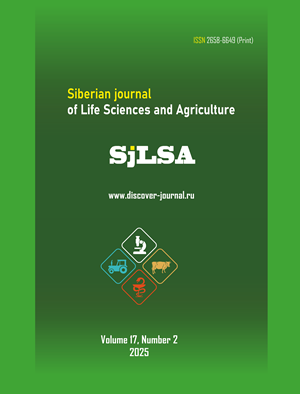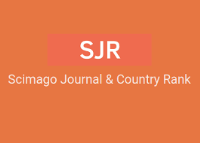Эффективные методы лесной селекции и сортового семеноводства для лесомелиорации аридных территорий Европейской России
Аннотация
Обоснование. Селекционно-генетическая основа является основным приемом, повышающим качество, жизнеспособность насаждений и их эффективность. Комплексные исследования и внедрение полученных результатов позволяют решить проблему селекции, размножения ценного генофонда, организации постоянной лесосеменной базы подбора растений.
Цель. Подбор перспективных древесных пород для аридного региона (Европейская территория России) на основе эффективных методов повышения устойчивости насаждений для лесной селекции и семеноводства.
Материалы и методы. Генетическая оценка лесосеменных плантаций проводилась при помощи дисперсионного анализа, коэффициентов повторяемости и наследуемости, доли влияния на фенотипы генетических и экологических факторов. Выделение генотипов проводилось при помощи инвентаризации на уровне конкурсного испытания по набору положительных признаков и степени их ценности у каждого исследуемого вида. Проводилось ранжирование таксационных показателей с целью отбора перспективных клонов и семей для высокоурожайных лесосеменных плантаций с признаками интенсивного роста. В исследованиях использовали полевые и лабораторные методы: фенологические, морфологические, физиолого-биохимические.
Результаты. Установлено, что путём повторного введения в культуру отбора возрастных репродуцентов с хорошей жизненностью и устойчивостью к неблагоприятным факторам окружающей среды особей можно значительно повысить устойчивость насаждений различного назначения. Хорошую сохранность и таксационные показатели исследуемых пород можно связать с формированием в насаждениях интразональной экологической обстановки. Высокая эффективность отбора гибридных форм подтверждается, так как все исследуемые растения имели удовлетворительное состояние и высокий процент сохранности.
Выводы. Разработанная схема повышения устойчивости ЗЛН (защитных лесных насаждений) позволит создать ценный селекционный фонд для агролесомелиоративного обустройства, к основным породам которого относятся Robinia pseudoacacia L., Quercus robur L., Pyrus communis subsp. pyraster (L.) Ehrh., Ulmus pumila L., Fraxinus excelsior L., Fraxinus pennsylvanica Marshall., Pinus nigra subsp. pallasiana (Lamb.), Pinus silvestris L. Влияние насаждения на плодоношения клонового потомства недостоверно, влияние маточника отличается достоверностью на уровне 1-5 % значимости в отношении плюсовых деревьев на плантации. Породный состав насаждений Новоаннинской популяции отнесен к перспективным и может претендовать на статус культурного сорта.
Информация о спонсорстве. Работа выполнена в рамках Государственного задания № FNFE – 2025-0009 «Создание новых генотипов, сортов, форм древесных, кустарниковых, культурных растений с высокоценными признаками продуктивности, качества, устойчивостью к био- и абиострессорам с использованием классических и современных методов селекции, новые инновационные технологии в питомниководстве и семеноводстве, для решения задач по предотвращению деградации и опустынивания агроландшафтов в условиях изменяющегося климата».
EDN: KEVYQR
Скачивания
Литература
Antwi, E. K., Boakye-Danquah, J., Owusu-Banahene, W., et al. (2022). Global review of cumulative effects assessments of disturbances on forest ecosystems. Journal of Environmental Management, 317, 115277. https://doi.org/10.1016/j.jenvman.2022.115277
Alfaro, R. I., Fady, B., Vendramin, G. G., et al. (2014). The role of forest genetic resources in responding to biotic and abiotic factors in the context of anthropogenic climate change. Forest Ecology and Management, 333, 76-87. https://doi.org/10.1016/j.foreco.2014.04.006 EDN: https://elibrary.ru/uopkzz
O’Neill, A. G., Stoehr, M., Jaquish, B. (2014). Quantifying safe seed transfer distance and impacts of tree breeding on adaptation. Forest Ecology and Management, 328, 122-130. https://doi.org/10.1016/j.foreco.2014.05.039
Callaway, R. M., Ridenour, W. M., Laboski, T., et al. (2005). Natural Selection for Resistance to the Allelopathic Effects of Invasive Plants. Journal of Ecology, 93(3), 576–583.
Calleja-Rodriguez, A., Li, Z., Hallingbäck, H. R., et al. (2019). Analysis of phenotypic- and Estimated Breeding Values (EBV) to dissect the genetic architecture of complex traits in a Scots pine three-generation pedigree design. Journal of Theoretical Biology, 462, 283-292. https://doi.org/10.1016/j.jtbi.2018.11.007
Crossa, J., Pérez-Rodríguez, P., Cuevas, J., et al. (2017). Genomic Selection in Plant Breeding: Methods, Models, and Perspectives. Trends in Plant Science, 22(11), 961-975. https://doi.org/10.1016/j.tplants.2017.08.011
Du, Y., Mi, X., Liu, X., et al. (2009). Seed dispersal phenology and dispersal syndromes in a subtropical broad-leaved forest of China. Forest Ecology and Management, 258(7), 1147-1152. https://doi.org/10.1016/j.foreco.2009.06.004
Dungey, H. S., Dash, J. P., Pont, D., et al. (2018). Phenotyping Whole Forests Will Help to Track Genetic Performance. Trends in Plant Science, 23(10), 854-864. https://doi.org/10.1016/j.tplants.2018.08.005
Faucon, M.-P., Houben, D., Lambers, H. (2017). Plant Functional Traits: Soil and Ecosystem Services. Trends in Plant Science, 22(5), 385-394. https://doi.org/10.1016/j.tplants.2017.01.005 EDN: https://elibrary.ru/oybaih
Graudal, L., Dawson, I. K., Hale, I., et al. (2022). Systems approach’ plant breeding illustrated by trees. Trends in Plant Science, 27(2), 158-165. https://doi.org/10.1016/j.tplants.2021.09.009 EDN: https://elibrary.ru/leggpy
Geburek, T., & Myking, T. (2018). Evolutionary consequences of historic anthropogenic impacts on forest trees in Europe. Forest Ecology and Management, 422, 23-32. https://doi.org/10.1016/j.foreco.2018.03.055 EDN: https://elibrary.ru/ygcmfn
Gibson, C., & Warren, A. (2020). Keeping time with trees: Climate change, forest resources, and experimental relations with the future. Geoforum, 108, 325-337. https://doi.org/10.1016/j.geoforum.2019.02.017
Harfouche, A. L., Jacobson, D. A., Kainer, D., et al. (2019). Accelerating Climate Resilient Plant Breeding by Applying Next-Generation Artificial Intelligence. Trends in Biotechnology, 37(11), 1217-1235. https://doi.org/10.1016/j.tibtech.2019.05.007 EDN: https://elibrary.ru/cqzlnj
Heidari, P., Rezaei, M., Sahebi, M., et al. (2019). Phenotypic variability of Pyrus boissieriana Buhse: Implications for conservation and breeding. Scientia Horticulturae, 247, 1-8. https://doi.org/10.1016/j.scienta.2018.11.075
Hlásny, T., Augustynczik, A. L. D., & Dobor, L. (2021). Time matters: Resilience of a post-disturbance forest landscape. Science of The Total Environment, 799, 149377. https://doi.org/10.1016/j.scitotenv.2021.149377 EDN: https://elibrary.ru/ayjkhk
He, T., & Li, C. (2020). Harness the power of genomic selection and the potential of germplasm in crop breeding for global food security in the era with rapid climate change. The Crop Journal, 8(5), 688-700. https://doi.org/10.1016/j.cj.2020.04.005 EDN: https://elibrary.ru/zfyynz
İçgen, Y., Kaya, Z., Çengel, B., et al. (2006). Potential impact of forest management and tree improvement on genetic diversity of Turkish red pine (Pinus brutia Ten.) plantations in Turkey. Forest Ecology and Management, 225(1-3), 328-336. https://doi.org/10.1016/j.foreco.2006.01.009
Kang, K.-S., El-Kassaby, Y. A., Han, S.-U., et al. (2005). Genetic gain and diversity under different thinning scenarios in a breeding seed orchard of Quercus accutissima. Forest Ecology and Management, 212(1-3), 405-410. https://doi.org/10.1016/j.foreco.2005.03.063
Khazipova, A., Chafizov, A., & Komissarov, A. (2020). Choice of Melioration Facies Regimes Using Catenary-facies Models of Watersheds of the Forest-steppe Zone of the Republic of Bashkortostan. Asian Journal of Water, Environment and Pollution, 17(1), 19-26. https://doi.org/10.3233/AJW200002 EDN: https://elibrary.ru/xkdfkd
Kim, I. S., Lee, K. M., Shim, D., et al. (2020). Plus Tree Selection of Quercus salicina Blume and Q. glauca Thunb. and Its Implications in Evergreen Oaks Breeding in Korea. Forests, 11(735). https://doi.org/10.3390/F11070735 EDN: https://elibrary.ru/wslдап
Kollmann, J., & Bañuelos, M. J. (2004). Latitudinal Trends in Growth and Phenology of the Invasive Alien Plant Impatiens glandulifera (Balsaminaceae). Diversity and Distributions, 10(5-6), 377-385. https://doi.org/10.1111/j.1366-9516.2004.00126.x
Kroll, A. J., Johnston, J. D., Stokely, T. D., et al. (2020). From the ground up: Managing young forests for a range of ecosystem outcomes. Forest Ecology and Management, 464, 118055. https://doi.org/10.1016/j.foreco.2020.118055 EDN: https://elibrary.ru/mxnycl
Kryuchkov, S. N., Vdovenko, A. V., Vorobyova, O. M., et al. (2021). Technology of growing planting material of woody species in arid conditions of Southern Russia. Volgograd State Pedagogical University, 108 p.
Kumar, A., Kumar, P., Sharma, A., et al. (2022). Scientific insights to existing know-how, breeding, genetics, and biotechnological interventions pave the way for the adoption of high-value underutilized super fruit Sea buckthorn (Hippophae rhamnoides L.). South African Journal of Botany, 145, 348-359. https://doi.org/10.1016/j.sajb.2021.11.045
Lantz, V., McMonagle, G., Hennigar, C., et al. (2022). Forest succession, management and the economy under a changing climate: Coupling economic and forest management models to assess impacts and adaptation options. Forest Policy and Economics, 142, 102781. https://doi.org/10.1016/j.forpol.2022.102781
Lelli, С., Bruun, H. H., Chiarucci, A., et al. (2019). Biodiversity response to forest structure and management: Comparing species richness, conservation relevant species and functional diversity as metrics in forest conservation. Forest Ecology and Management, 432, 707-717. https://doi.org/10.1016/j.foreco.2018.09.057
Liu, J. (2022). From afforestation to forest landscape restoration in DPRK: Gaps and challenges. Trees, Forests and People, 8, 100243. https://doi.org/10.1016/j.tfp.2022.100243 EDN: https://elibrary.ru/iutpaw
MacLachlan, I. R., Wang, T., Hamann, A., et al. (2017). Selective breeding of lodgepole pine increases growth and maintains climatic adaptation. Forest Ecology and Management, 391, 404-416. https://doi.org/10.1016/j.foreco.2017.02.008
Mölder, A., Sennhenn-Reulen, H., & Fischer, C. (2019). Success factors for high-quality oak forest (Quercus robur, Q. petraea) regeneration. Forest Ecosystems, 6(49). https://doi.org/10.1186/s40663-019-0206-y
Orton, T. J. (2020). Horticultural Plant Breeding. Academic Press, pp. 97-112. https://doi.org/10.1016/B978-0-12-815396-3.00006-8
Santos, M. P., Araujo, M. J., & Silva, P. H. M. (2021). Natural establishment of Pinus spp. around seed production areas and orchards. Forest Ecology and Management, 494, 119333. https://doi.org/10.1016/j.foreco.2021.119333
Sampaio, T., Gonçalve, E., Patrício, M. S., et al. (2019). Seed origin drives differences in survival and growth traits of cork oak (Quercus suber L.) populations. Forest Ecology and Management, 448, 267-277. https://doi.org/10.1016/j.foreco.2019.05.001
Sagra, J., Ferrandis, P., Plaza-Álvarez, P. A., et al. (2018). Regeneration of Pinus pinaster Aiton after prescribed fires: Response to burn timing and biogeographical seed provenance across a climatic gradient. Science of The Total Environment, 637–638, 1550-1558. https://doi.org/10.1016/j.scitotenv.2018.05.138
Sedgley, M., & Griffin, A. R. (1989). Fruit- and Seed-production Management and Tree Breeding. Applied Botany and Crop Science, Sexual Reproduction of Tree Crops, pp. 229-290. https://doi.org/10.1016/B978-0-12-634470-7.50014-3
Seidler, R. (2017). Patterns of Biodiversity Change in Anthropogenically Altered Forests. Reference Module in Life Sciences. https://doi.org/10.1016/B978-0-12-809633-8.02186-5
Silva Ramos, C. A., Soares, T. L., Santos Barroso, N., et al. (2021). Influence of maturity stage on physical and chemical characteristics of fruit and physiological quality of seeds of Physalis angulata L. Scientia Horticulturae, 284, 110124. https://doi.org/10.1016/j.scienta.2021.110124
Solomentseva, A. S., Kolmukidi, S. V., Lebed, N. I., et al. (2020). Tree-shrub species promising for protective afforestation and planting in the Volgograd region. IOP Conference Series: Earth and Environmental Science, 012056. https://doi.org/10.1088/1755-1315/579/1/012056 EDN: https://elibrary.ru/qzssrj
Song, P., Wang, J., Guo, X., et al. (2021). High-throughput phenotyping: Breaking through the bottleneck in future crop breeding. The Crop Journal, 9(3), 633-645. https://doi.org/10.1016/j.cj.2021.03.015 EDN: https://elibrary.ru/tbpdkq
Spengler, R. N. (2020). Anthropogenic Seed Dispersal: Rethinking the Origins of Plant Domestication. Trends in Plant Science, 25(4), 340-348. https://doi.org/10.1016/j.tplants.2020.01.005 EDN: https://elibrary.ru/tszjbk
Spalvins, A., Eglite, I., & Lace, I. (2020). Modelling of the forest melioration system at Latvia. A case study. 20th International Multidisciplinary Scientific GeoConference SGEM, 257-264. https://doi.org/10.5593/sgem2020/3.1/s12.034 EDN: https://elibrary.ru/rakvmb
Tzfira, T., Zuker, A., & Altman, A. (1998). Forest-tree biotechnology: genetic transformation and its application to future forests. Trends in Biotechnology, 16(10), 439-446. https://doi.org/10.1016/S0167-7799(98)01223-2
Urruth, L. M., Braun Bassi, J., & Chemello, D. (2022). Policies to encourage agroforestry in the Southern Atlantic Forest. Land Use Policy, 112, 105802. https://doi.org/10.1016/j.landusepol.2021.105802 EDN: https://elibrary.ru/iwukai
Vivas, M., Wingfield, M. J., & Slippers, B. (2020). Maternal effects should be considered in the establishment of forestry plantations. Forest Ecology and Management, 460, 117909. https://doi.org/10.1016/j.foreco.2020.117909 EDN: https://elibrary.ru/nioumw
Zhao, Y., Li, M., Deng, J., et al. (2021). Afforestation affects soil seed banks by altering soil properties and understory plants on the eastern Loess Plateau, China. Ecological Indicators, 126, 107670. https://doi.org/10.1016/j.ecolind.2021.107670
Copyright (c) 2025 Sergey N. Kryuchkov, Alexander I. Belyaev, Anna M. Pugacheva, Alexandra S. Solomentseva, Sergey A. Egorov, Almagul’ K. Romanenko

Это произведение доступно по лицензии Creative Commons «Attribution-NonCommercial-NoDerivatives» («Атрибуция — Некоммерческое использование — Без производных произведений») 4.0 Всемирная.

























































